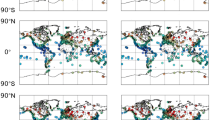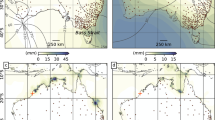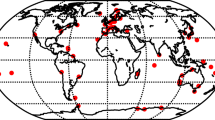Abstract
We investigate daily and sub-daily non-tidal oceanic and atmospheric loading (NTOAL) in the Australian region and put an upper bound on potential site motion examining the effects of tropical cyclone Yasi that crossed the Australian coast in January/February 2011. The dynamic nature of the ocean is important, particularly for northern Australia where the long-term scatter due to daily and sub-daily oceanic changes increases by 20–55 % compared to that estimated using the inverted barometer (IB) assumption. Correcting the daily Global Positioning System (GPS) time series for NTOAL employing either a dynamic ocean model or the IB assumption leads to a reduction of up to 52 % in the weighted scatter of daily coordinate estimates. Differences between the approaches are obscured by seasonal variations in the GPS precision along the northern coast. Two compensating signals during the cyclone require modelling at high spatial and temporal resolution: uplift induced by the atmospheric depression, and subsidence induced by storm surge. The latter dominates (\(>\)135 %) the combined net effect that reaches a maximum of 14 mm, and 10 mm near the closest GPS site TOW2. Here, 96 % of the displacement is reached within 15 h due to the rapid transit of cyclones and the quasi-linear nature of the coastline. Consequently, estimating sub-daily NTOAL is necessary to properly account for such a signal that can be 3.5 times larger than its daily-averaged value. We were unable to detect the deformation signal in 2-hourly GPS processing and show that seasonal noise in the Austral summer dominates and precludes GPS detection of the cyclone-related subsidence.












Similar content being viewed by others
References
Boy JP, Hinderer J, Gegout P (1998) Global atmospheric loading and gravity. Phys Earth Planet Int 109:161–177
Boy JP, Lyard F (2008) High-frequency non-tidal ocean loading effects on surface gravity measurements. Geophys J Int 175:35–45. doi:10.1111/j.1365-246X.2008.03894.x
Boy JP, Longuevergne L, Boudin F, Jacob T, Lyard F, Llubes M, Florsch N (2009) Modelling atmospheric and induced non-tidal oceanic loading contributions to surface gravity and tilt measurements. J Geodyn 48:182–188. doi:10.1016/j.jog.2009.09.022
Bruinsma S, Lemoine JM, Biancale R, Valès N (2010) CNES/GRGS 10-day gravity field models (release 2) and their evaluation. Adv Space Res 45:587–601
Carrère C, Lyard F (2003) Modelling the barotropic response of the global ocean to atmospheric wind and pressure forcing: comparisons with observations. Geophys Res Lett 30(6):1275. doi:10.1029/2002GL016473
Coleman R, Dickey JM, Featherstone W, Higgins M, Johnston G, Lambeck K, Lovell JEJ, McQueen H, Rizos C, Tingay S, Tregoning P, Twilley C, Watson CS (2008) New geodetic infrastructure for Australia. J Spat Sci 53(2):65–80
Dee DP, Uppala SM, Simmons AJ, Berrisford P, Poli P, Kobayashi S, Andrae U, Balmaseda MA, Balsamo G, Bauer P, Bechtold P, Beljaars ACM, van de Berg L, Bidlot J, Bormann N, Delsol C, Dragani R, Fuentes M, Geer AJ, Haimberger L, Healy SB, Hersbach H, Hólm EV, Isaksen L, Kållberg P, Köhler M, Matricardi M, McNally AP, Monge-Sanz BM, Morcrette JJ, Park BK, Peubey C, de Rosnay P, Tavolato C, Thépaut JN, Vitart F (2011) The ERA-Interim reanalysis: configuration and performance of the data assimilation system. Quart J Royal Meteo Soc 137(656):553–597. doi:10.1002/qj.828
Dziewonski AM, Anderson DL (1981) Preliminary reference Earth model. Phys Earth Planet Int 25:297–356
Farrell WE (1972) Deformation of the Earth by surface loads. Rev Geophys Space Phys 10:761–797
Fratepietro F, Baker TF, Williams SDP, Van Camp M (2006) Ocean loading deformations caused by storm surges on the northwest European shelf. Geophys Res Lett 33(6). doi:10.1029/2005GL025475
Geng J, Williams SDP, Teferle FN, Dodson AH (2012) Detecting storm surge loading deformations around the southern North Sea using subdaily GPS. Geophys J Int 191(2):569–578. doi:10.1111/j.1365-246X.2012.05656.x
Haigh ID, Wijeratne EMS, MacPherson LR, Pattiaratchi CB, Mason MS, Crompton RP, George S (2014a) Estimating present day extreme water level exceedance probabilities around the coastline of Australia: tides, extra-tropical storm surges and mean sea level. Clim Dyn 42:139–147. doi:10.1007/s00382-012-1652-1
Haigh ID, MacPherson LR, Wijeratne EMS, Mason MS, Pattiaratchi CB, Crompton RP, George S (2014b) Estimating present day extreme water level exceedance probabilities around the coastline of Australia: tropical cyclone-induced storm surges. Clim Dyn 42:121–138. doi:10.1007/s00382-012-1653-0
Herring TA, King RW, McClusky SC (2010) Introduction to GAMIT-GLOBK. Massachusetts Institute of Technology, Cambridge pp 48
Kalnay E, Kanamitsu M, Kistler R, Collins W, Deaven D, Gandin L, Iredell M, Saha S, White G, Woollen J, Zhu Y, Leetmaa A, Reynolds R, Chelliah M, Ebisuzaki W, Higgins W, Janowiak J, Mo K, Ropelewski C, Wang J, Jenne R, Joseph D (1996) The NCEP/NCAR 40-year reanalysis project. Bull Am Meteor Soc 77:437–470
Lemoine JM, Bruinsma S, Loyer S, Biancale R, Marty JC, Perosanz F, Balmino G (2007) Temporal gravity field models inferred from GRACE data. Adv Space Res 39:1620–1629. doi:10.1016/j.asr.2007.03.062
Mémin A, Rogister Y, Hinderer J, Llubes M, Berthier E, Boy JP (2009) Ground deformation and gravity variations modelled from present-day ice thinning in the vicinity of glaciers. J Geodyn 48(3–5):195–203. doi:10.1016/j.jog.2009.09.006
Merriam JB (1992) Atmospheric pressure and gravity. Geophys J Int 109:488–500
Penna NT, King MA, Stewart MP (2007) GPS height time series: short-period origins of spurious long-period signals. J Geophys Res 112(B2). doi:10.1029/2005JB004047
Petit G, Luzum B (2010) IERS Conventions (2010). IERS Technical note no 36, Verlag des Bundesamts für Kartographie und Geodäsie Frankfurt am, Main, pp 179
Petrov L, Boy J (2004) Study of the atmospheric pressure loading signal in very long baseline interferometry observations. J Geophys Res-Solid Earth 109(B03405). doi:10.1029/2003JB002500
Ray J, Altamimi Z, Collilieux X, van Dam T (2008) Anomalous harmonics in the spectra of GPS position estimates. GPS Solut 12:55–64. doi:10.1007/s10291-007-0067-7
Schuh H, Estermann G, Crétaux JF, Bergé-Nguyen M, van Dam T (2003) Investigation of hydrological and atmospheric loading by space geodetic techniques. IAG Proc 126:123–132 Hwang C, Shum CK, Li JC (eds) International Workshop on Satellite Altimetry
Stammer D, Wunsch C, Fukumori I, Marshall J (2002) State estimation in modern oceanographic research. Eos Trans AGU 83(27):294–295. doi:10.1029/2002EO000207
Tierney C, Wahr J, Zlotnicki V (2000) Short-period oceanic circulation: implications for satellite altimetry. Geophys Res Lett 27:1255– 1258
Tregoning P, van Dam TM (2005) Atmospheric pressure loading corrections applied to GPS data at the observation level. Geophys Res Lett 32(22). doi:10.1029/2005GL024104
Tregoning P, Watson C (2009) Atmospheric effects and spurious signals in GPS analyses. J Geophys Res 114(39). doi:10.1029/2009JB006344
Tregoning P, Watson C (2011) Correction to atmospheric effects and spurious signals in GPS analyses. J Geophys Res 116(B2). doi:10.1029/2010JB008157
Tregoning P, Watson C, Ramillien G, McQueen H, Zhang J (2009) Detecting hydrologic deformation using GRACE and GPS. Geophys Res Lett 36(15). doi:10.1029/2009GL038718
van Dam TM, Wahr JM (1987) Displacements of the Earth’s surface due to atmospheric loading: effects on gravity and baseline measurements. J Geophys Res 92(B2):1281–1286
van Dam TM, Herring TA (1994) Detection of atmospheric pressure loading using very long baseline interferometry measurements. J Geophys Res 99(B3):4505–4517
van Dam TM, Blewitt G, Heflin MB (1994) Atmospheric pressure loading effects on global positioning system coordinate determinations. J Geophys Res 99(B12):23939–23950
van Dam TM, Collilieux X, Altamimi Z, Ray J (2012) Nontidal ocean loading: amplitudes and potential effects in GPS height time series. J Geod 86(11):1043–1057. doi:10.1007/s00190-012-0564-5
Williams SDP, Penna NT (2011) Non-tidal ocean loading effects on geodetic GPS heights. Geophys Res Lett 38(9). doi:10.1029/2011GL046940
Wunsch C (1972) Bermuda sea level in relation to tides, weather, and baroclinic fluctuations. Rev Geophys 10:1–49
Wunsch C, Stammer D (1997) Atmospheric loading and the oceanic inverted barometer effect. Rev Geophys 31:79–107
Zumberge JF, Heflin MB, Jefferson DC, Watkins MM, Webb FH (1997) Precise point positioning for the efficient and robust analysis of GPS data from large networks. J Geophys Res 102(B3):5005–5017. doi:10.1029/96JB03860
Acknowledgments
A. Mémin was supported by an Australian Research Council Super Science Fellowship (FS110200045). We thank the International GNSS Service and Geoscience Australia for making the GPS data used in this study freely available. The GPS data were computed on the Terrawulf II computational facility at the Research School of Earth Sciences, a facility supported through the AuScope initiative. AuScope Ltd. is funded under the National Collaborative Research Infrastructure Strategy (NCRIS), an Australian Commonwealth Government Programme. The authors thank F. Lyard and J.-P. Boy for providing the grids of the hydrodynamic Toulouse Unstructured Grid Ocean model. We also thank T. Van Dam for providing the loading time series computed using the ECCO model. The authors acknowledge comments from two anonymous reviewers, T. Van Dam and S. Williams.
Author information
Authors and Affiliations
Corresponding author
Rights and permissions
About this article
Cite this article
Mémin, A., Watson, C., Haigh, I.D. et al. Non-linear motions of Australian geodetic stations induced by non-tidal ocean loading and the passage of tropical cyclones. J Geod 88, 927–940 (2014). https://doi.org/10.1007/s00190-014-0734-8
Received:
Accepted:
Published:
Issue Date:
DOI: https://doi.org/10.1007/s00190-014-0734-8




